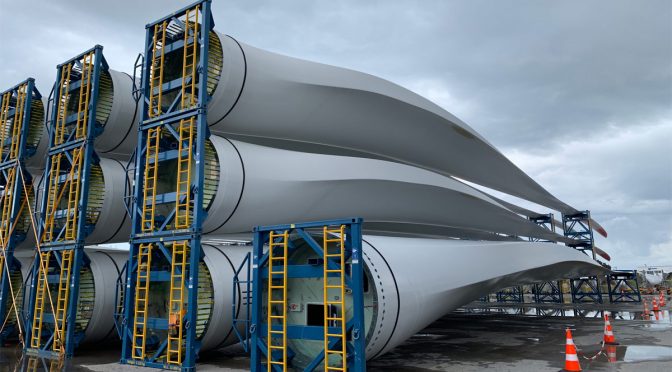Wind turbines already have a recyclability rate of 85% to 90%. Making turbines 100% recyclable is an important task for the wind industry – and we are making significant progress in the right direction. Most components of a wind turbine – the foundation, tower, components of the gear box and generator – are recyclable and are treated as such.
But turbine blades represent a specific challenge. Wind turbine blades are made up of composite materials that boost the performance of wind energy by allowing lighter and longer blades. Today 2.5 million tonnes of composite material are in use in the wind sector globally.
The complexity of this composite material requires specific processes for recycling. Today, the main technology for recycling composite waste is through cement co-processing. The wind industry produces far less composite waste than other industries. It produces less composite waste than the building and construction sector, the electrical and electronics sector, the transportation sector, and the marine sector. And it does this, while also generating clean energy. Further development and industrialisation of alternative technologies like solvolysis and pyrolysis will provide the wind industry with additional solutions for turbine blades reaching their end-of-life, and will enable the industry to deliver zero-waste turbines.
Just last month, Vestas announced its plans for zero-waste turbines. Ambition like this is key: the end-of-life issue requires rapid action. The first generation of wind turbines are now starting to come to the end of their operational life and be replaced by modern turbines. 14,000 wind turbine blades will be decommissioned in Europe the next five years. The recycling of these old blades is a top priority for the wind industry.
The industry has already teamed up with the chemical and compositors industries to find effective ways to do this. WindEurope, Cefic (the European Chemical Industry Council) and EUCIA (the European Composites Industry Association) have created a cross-sector platform to advance novel approaches to the recycling of wind turbine blades. And later this year, WindEurope will host the second edition of EOLIS, the End-of-Life Issues and Strategies Conference.
Want to know more about blade recycling? Last year, ETIP Wind published How Wind Is Going Circular, an overview on composite recycling in the wind industry.
Background information
Composite materials are being recycled today through cement co-processing, where the cement raw materials are being partially replaced by the glass fibres and fillers in the composite, and the organic fraction replaces coal as a fuel. Through that process, the CO2 output of the cement manufacturing process can be significantly reduced (up to 16 % reduction is possible if composites represent 75 % of cement raw materials).
Besides recycling through cement co-processing, alternative technologies like mechanical recycling, solvolysis and pyrolysis are being developed, ultimately providing the industry with additional solutions for end-of-life.
The EU must prioritise R&I funding to diversify and scale up recycling technologies as part of the next R&I framework programme, Horizon Europe. This is critical to Europe’s technology leadership as we embark on a global sustainable energy transition. In parallel, national governments should harmonise their implementation of EU regulations on waste treatment to help develop a pan-European market for recycled composites.


